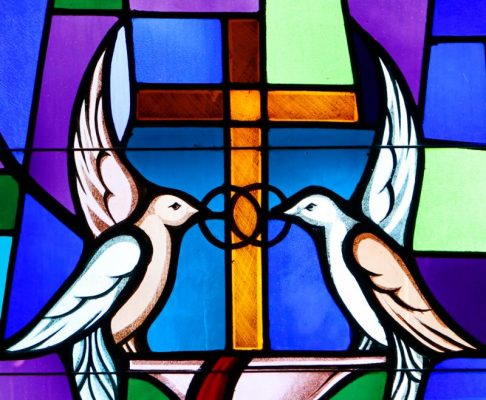This is the seventh and final article in a series on the seven sacraments. You can find all the articles of the series at http://stcloudvisitor.org/sacraments.
By John Grabowski
“What’s love got to do with it?” Tina Turner sang in her famous song by the same name. If her question is about the Catholic understanding of marriage, then the answer is both “not much” and “virtually everything.”
The first answer is especially true if you understand love as Turner’s song described it: an emotional response based on physical attraction. Marriage, as the church understands it, does not require these kinds of feelings of love.
Instead, marital consent is based on a free decision of the will on the part of a man and a woman to give themselves irrevocably to another.
A couple promises sexual fidelity and openness to the gift of children before God and (typically) human witnesses. This brings into being the covenant of marriage. Sacramental and even nonsacramental marriages are characterized by unity (which Scripture describes as being “one flesh” — Genesis 2:24) and indissolubility.
In biblical times and in some cultures today, families might help to arrange a marriage between individuals who do not know one another well — let alone experience being “in love” with each other.

For such a marriage to be valid, the couple must give their free consent — to give themselves to each other in the way specified by the goods of faithfulness and children. Feelings of love are not a legal or theological requirement.
Certainly, over time, as such couples come to know each other and live together, they come to recognize love at the heart of their relationship.
Think of Tevye and Golde in “Fiddler on the Roof,” confronted with their daughters falling in love, one after the other, asking each other, “Do you love me?” after 25 years of marriage. But, their love is deeper than mere attraction or emotion — it is a love embodied in lives of mutual service and care.
Like Tevye and Golde’s daughters, in our current Western culture it is more common for people to marry for love. Pope Francis acknowledges this in his apostolic exhortation on the joy of love, “Amoris Laetitia” (Nos. 131-32).
But this love is more than feelings of emotional closeness or attraction that wax and wane over time. This is one reason why Pope Francis recommends in the document that couples work to protect their marriage from dangers such as busyness, resentments, jealousy or infidelity.
This deeper love is fostered by communication, kindness, forgiveness, touch, working through conflict or crises in nondestructive ways, and sharing their lives of faith. These various kinds of intimacy form the backdrop and context for passion and sexual expression in marriage (Nos. 142-52).

All of this is equally true of the marriage covenant whether it is found in a natural or a sacramental marriage. The church understands that a merely natural marriage cannot exist between two baptized persons. They can only have a sacramental marriage (see the Code of Canon Law, Canon 1055.2).
In the understanding of the Western (Latin) church, it is the couple themselves who act as ministers and confer the sacrament on one another (see the Catechism of the Catholic Church, No. 1623). The presence of a bishop, priest or deacon (required for Catholics) is necessary to have an official witness on behalf of the church.
When a couple exchanges valid consent that is properly witnessed and sexually consummates their marriage, it is absolutely indissoluble. No human power — whether of the church or the state — can dissolve or nullify it. The sacrament creates a bond between the couple, which serves as an ongoing source of grace. It is not as if they only receive a one-time “injection” of grace on their wedding day.
The bond gives them power throughout their lives to love, serve, forgive, and to welcome and form their children. This stream of grace is continually strengthened and refreshed in the sacraments of reconciliation and the Eucharist — the “source and summit” of their Christian life and love, as the catechism states (No. 1324).
In “Amoris Laetitia,” Pope Francis teaches that the sacrament of marriage is not merely a “thing” or an impersonal power. It is an encounter with the person of Jesus who strengthens, heals and walks with the couple in their life together (No. 73).
Pope Francis thus builds on the teaching of St. John Paul II on marriage and in his theology of the body catechesis.
Christian marriage takes all of the human dimensions of attraction, emotion, friendship and sacrificial service spoken by the couple in their daily life together and makes them a language that communicates the nuptial love of Christ for the church (Ephesians 5:32).
This “language of the body,” first spoken in the couple’s vows, becomes a prophecy of the whole of their life together. In this sense, marriage is “the sacrament of love” and a Christian couple is its icon in the world.
So, “what’s love got to do with it”? Everything!
John Grabowksi is associate professor of moral theology/ethics at The Catholic University of America.
‘Made for Love’ podcast
A new Catholic storytelling podcast, “Made for Love,” launched in January. Produced and narrated by Sara Perla, program specialist for the Promotion and Defense of Marriage at the U.S. Conference of Catholic Bishops, the podcast explores themes of marriage and family life by telling the stories of Catholics who are “living out the call to love.” Find the podcast online at www.marriageuniqueforareason.org/podcast/ and on iTunes under USCCB Clips.






















